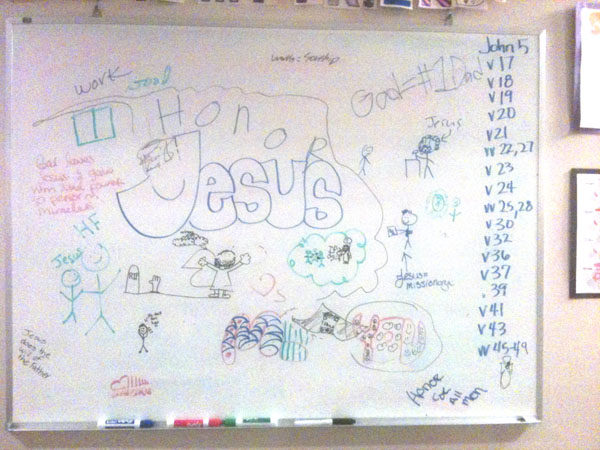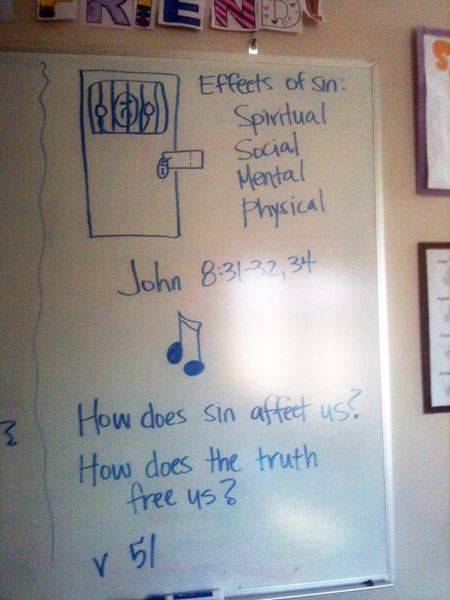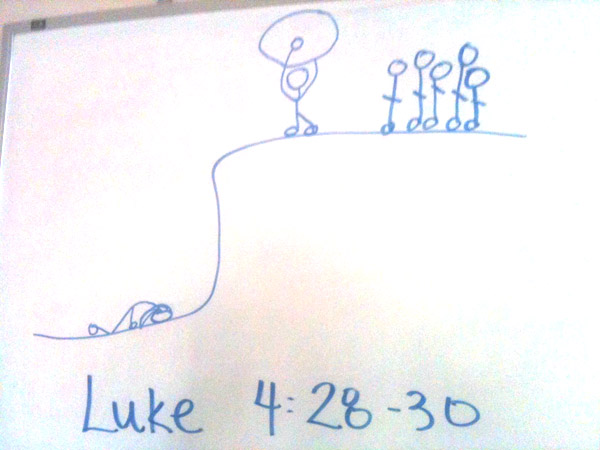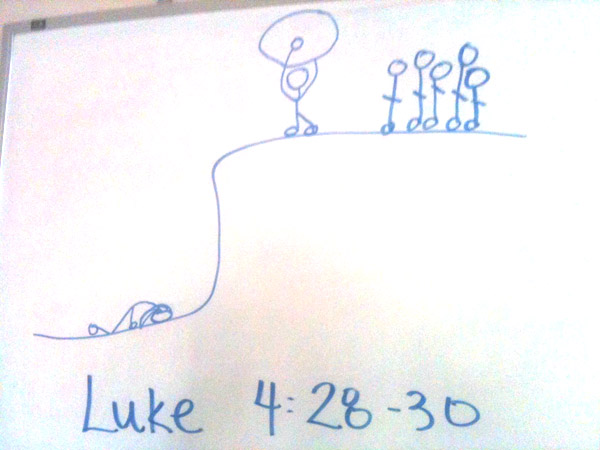Hello, friends. It’s been a long time :). I’m sure you can appreciate why, what with three holidays in a month, plus new pages for all the 2013 stuff, plus 4 family birthdays, plus teaching Seminary, plus two funerals, plus trying to keep my marriage intact during the culmination of an eight month web site upgrade during the past 5 weeks — I’ve been busy.
We have recently begun using a CDN to help serve traffic on the websites. It seems to be helping. I have also been able to do some traffic analysis with CloudFlare and AWStats to help determine where so much of this spam and crash-causing traffic is coming from. Turns out that a great deal of traffic is coming from crawlers and bots that I think we can block, so Jared is on that today. He also broke the store somehow, so he’s trying to fix that. Sorry to all of you who are trying to order wristbands. (They’re sold out temporarily during last week’s whirlwind, so they can’t ship anyway.)
Anyway, weekday traffic is up to normal weekend levels as is typical at the beginning of the year. Some 8,000 of you visit each day during January, with many more visiting on the weekends. We switched MormonShare to the new server last weekend, and after we do a full week of heavy traffic testing, I will move JennySmith.net over. My $450/month double web hosting fee is getting old.
Today I’m working on fixing and improving some of the views that got broken during the upgrade. Primary Monthly Themes and the old YW lessons pages are there, but there’s no template to format the data in the way you’re used to. I may also change the clipart pages back to the “show a graphic/title” format instead of the display teaser method I’ve been using. I’m working really hard to simplify and get rid of extraneous visual fluff that can distract people from getting to the content they’re trying to find.
Anyway. Yes, the website is consuming me. And yet, Seminary continues. Today I’m posting my lessons from John since I will be out of town most of next week. My sub will cover John 9-11, and I will kick off our FOURTH AND FINAL time through the last week of Christ’s life when I get back with John 12.
John 1
Lesson Objectives: Students will learn about John and his purposes in writing his gospel. They will glean their own increased understanding of John’s words from the JST and D&C. They will appreciate Nathaniel.
I always have my students read the Bible Dictionary (BD) entry for whatever book we’re studying during our first day covering that material. I started doing that when I was teaching Old Testament, and it has made a big difference in our understanding of why the book authors were writing and who they were. I also spent a good deal of time in the BD, Gospels, Chronology of entry showing the kids how different John is than the other gospel writers. My students have been relieved to have something a little different to cover. Using some other handouts I have given them, I mentioned some of the names John was known by like John the Revelator, John the Beloved, Saint John, and Son of Thunder. I love John.
Since I knew my kids would have questions about the difficult parts of John 1, before I took any questions, I had students turn to the JST-Appendix for John 1:1–34 and had them read those verses silently. I also had them read D&C 93:6–17. This was the first time I have ever had the kids read such a big volume of material silently during class, and frankly, I was nervous. I know I harp on this all the time, but having the kids read the text before class makes such a huge difference. They came confused and with questions, and so when I framed the reading as including answers and clarification, they were willing to read without complaint. I’m always so grateful they are willing to trust me when I push them into something a little different.
We talked for a few minutes about the things they learned about the Word after their reading and I asked some of the students to point out some of the new things they learned from the JST. Thank heaven for Joseph Smith.
Next I spent a few minutes zipping through the next few verses before Nathanael. I pointed out v 37, 40. One of these disciples was Andrew, Simon Peter’s brother, and the other is assumed to be John himself. I also hit on vv 41-42 and 42a. When we’ve found the Savior, are we like Andrew — anxious to share that information with our friends and family?
We spent a few minutes talking about Nathanael. I love that this story is right at the beginning of John because for me it is a little bit humorous. John is one of the few scripture writers whose sense of humor comes through in his writing — at least for me — and that’s one of the reasons I love him so much. We talked about what it meant to be without guile. My kids loved the “winky face” that almost seemed strategically places in these verses, vv 43-51.
John 2
John calls the changing of water to wine Christ’s first miracle in Galilee. I started out by asking if the kids thought that Christ was a little bit rude to his mother in v 4. Checking the footnote, we learn that Jesus was, of course, never rude to his mother. We must follow his example and speak respectfully to our parents as well.
Now I had the kids turn their attention to vv 3-5 and focus in on Mary. I asked them to look at these verses and explain to the class what they teach us about Mary. The things I wanted to point out were
- She had total faith in her son.
- She directed others to follow him.
- She knew he’d answer her petition.
- She knew he had power to act.
We spent several minutes talking about how impressive this level of faith was. How do you think we can get the kind of faith in Christ that Mary had?
One of my students did mention that maybe it was Christ’s wedding. That seems pretty unlikely to me — “Hey, we’re running out of wine at your wedding. Think you could drop everything and go take care of it?” Whatever the circumstance, I just said we didn’t really know whose wedding it was. Mary was obviously in some kind of authority though. It could have been a cousin, friend, another child, or maybe she was just the Relief Society president.
John 3
Lesson Objective: Students will learn what it means to be born of the Spirit and why we must be so.
I opened the lesson by asking students to imagine that they are at school or work today and the topic of religion comes up. Someone says they’ve been saved — why would they need to be baptized? What would you say? How many of you could immediately turn to a scripture and answer that question? I asked students to think about how prepared they were to answer questions about the gospel.
In our scripture mastery passage, John 3:5, Jesus Christ taught us we must be baptized by water and of the spirit. Your [imaginary] friend is not the first to ask the question why — in fact, Adam asked this very same question in Moses 6:65–66, 61. We read those verses aloud and discussed them.
After our discussion, I had students complete the following writing exercise in their notebooks and explained they would be sharing their answers at the end of class: “Using the Law of Witnesses, explain why we must be born of water and the Spirit.” My students know that the Law of Witnesses means they must be able to back up their assertions with multiple scriptures or quotes, with three or more being preferable. Some of them used their desk copies of True to the Faith, some used their electronic scripture search, and others used the Topical Guide to complete the exercise. We only had about five minutes to start writing, so I had them leave their papers on their tables and we finished that writing exercise and shared some of the writings the next day.
I think this activity was particularly effective because I gave them a starting point and then let them use their scripture study helps to expand the answer in their own words.
John 4
I wish I had known about the new Woman at the Well movie. One of our missionaries told me about it at church the next Sunday. It’s probably the best of the Church’s free Bible videos.
Lesson Objective: Students will learn some information regarding patterns of conversion valuable for missionary effort.
For this activity I decided to use the Woman at the Well as an example of the conversion process. After the previous day’s lesson where many of my soon-to-be-missionary students discovered they could not even answer a simple question like “why should I be baptized?” this lesson worked out great. I always try to watch and see who is marking scriptures during our lessons to get a feel for what is sticking, and this lesson and the previous one really got the boys’ attention.
We went through this verse by verse and I added commentary. I can’t say that I executed this lesson as well as I should have. I should have used a more interesting way to cover the material. The video would have helped :-/
Here are my notes
v 6 – Jesus is tired, hungry, it’s hot
v 7 – Jesus strikes up a conversation about surroundings (I pointed out that one of our SI bosses is a former mission president, and he said one of the things his missionaries needed the most help with was learning to strike up a conversation with a stranger.)
v 10 – Jesus changes the subject to religion
vv 11-12 – She wasn’t getting it at first
vv 13-14 – He persists, patiently explains
v 16 – includes family in discussion
v 19 – she begins to recognize his authority
v 20 – he follows her topic, brings it to gospel, teaches
v 25 – she says what she knows
v 26 – he builds on it
v 28 – she then testifies to others
v 37 – One soweth and another reapeth = those that set the stage don’t always get the blessing of the harvest. This is an important lesson for us in missionary work. You might be a sower or a reaper. Both jobs are essential. In this case they mentioned prophets as preparing the way for a future harvest, but so do ordinary members.
v 39 – many believed because of her testimony
vv 41-41 – others believed as they met him, true testimonies (v 40) wanted him to stay on.
At the beginning of this lesson I answered a question a student had asked me about John 3:13. I taught the kids again the process by which we can answer questions. This question didn’t have a footnote or related study helps entry, so I looked up the commentary in the Seminary and Insitute manuals. Nothing. Then I turned to the handy dandy http://scriptures.byu.edu/ website and showed them again how to use that site. It was new for my freshmen, but some of last year’s students remembered it. That site is an index of every conference talk since 1932 plus Journal of Discourses and History of the Church indexed by book, chapter, and verse. It is incredibly helpful when you have a question about a specific verse.
I spent a few minutes at the beginning of class showing the kids John 4:1a and cross-referencing it with the scripture in John 2 that talks about Jesus baptizing. He did perform baptisms and was an example to us by doing so. One student pointed out that Jesus let his disciples most of the baptizing just like I don’t give kids the answers right away when they ask me a question — I make them look it up or search out the answer themselves so they can learn how. I was so pleased! It was probably the best compliment I’ve had all year!
John 5
I started out by having the kids read v 4, and I asked, “What do you know about God that shows the angel stirring the water must be a false supersition?” I thought reading the verse would be enough set up, but the question still wasn’t clear, and after a little bit of explaining, they understood what I was asking. Basically, they know that God doesn’t play favorites. He doesn’t base his blessings on who can run the fastest but on righteousness. I had a scripture ready Acts 10:34–35, but I didn’t need it.
I touched briefly on v14 – What is the “worse thing” referred to in this verse. Why is it worse?
vv 17-47. For this I had written down several verses and the kids took a verse and told the group what they learned about Jesus Christ. The verses I used were 17, 18, 19, 20, 21, 22 and 27, 23, 24, 25 and 28, 30,32,36,37,39,41,43, and 45-47. We used the Delilah activity to choose verse order.

Sorry about the quality of my photos. I have an iPhone 3. The camera is unbelievably bad.
This was not my best lesson. Definitely too choppy. Though the little chunks of lesson were okay, transitions between topics were poor, resulting in a disjointed awkward feel to the lesson. After writing the lesson activities I should have come up with better transitions or an over all theme. I also didn’t write a lesson objective, which would have helped me focus, too.
Christmas Party
For Christmas I gave each student a miniature oil lamp ($2.99 ea) and two replica widow’s mites ($3.49 for pack of 10) I bought at Christianbook.com. Several of the kids really liked their lamps, but not one kid commented on the mites to my surprise.
John 6
This was my first lesson after the break. My goal was for the students to learn some skills that will prevent them from running when times are hard.
Today we used the styrofoam plates (we call them ghetto slates) activity to let the students share what they did over the holiday. Each wrote their answers on their slate and then flashed their answers
It’s 6:20 am Christmas Morning. Where were you?
It’s 11:45pm New Year’s Eve. Where were you?
I had planned to use a transition to my lesson of “Now shifting gears, it’s about 4pm in Galilee, year 31 AD. You have just heard the Bread of Life sermon. How is Jesus like bread?” or maybe even “Where are you? Did you leave with the main group or stay with the twelve apostles?” But I didn’t. Can’t remember why now, honestly.
Anyway, we moved to tables and I explained a little background on the sermon. Jesus has returned to Galilee after healing the man at the pool of Bethesda. Then I asked a couple of questions to get the following quick points:
- The people see him feed 5,000 and want to take him “by force” to be a king (v 15). [My kids were pretty good about discussing this. Some asked why would any one force someone else to be a king, of all things? Who wants to be bossed around? One said, well, I’d want a king who could guarantee I’d never be hungry. Truly Christ does do that. He feeds our spirits so they need never be hungry. Anyway, I love it when they answer their own questions.]
- The people hunt Christ down after his water escape. v 24
- Why are they seeking him? Free Food! v 26 Why is that a problem?
Jesus gave a speech here called the Bread of Life sermon. It’s a pivotal speech, but difficult for many to hear. Afterwards many “walked no more with him” v 66.
I had planned to go verse by verse and discuss this, but the sermon is too long, and my last attempt at that hadn’t worked out, so I did a worksheet instead. You can download the Bread of Life worksheet I made here. I showed the class part of a video from Messiah: Behold the Lamb of God called He Went Up Into a Mountain from BYUTV. The video is available online if you want to see it. I asked the kids to watch the video and write the things they learned from the video or their reading on the slice of bread on their handout. Then we worked on the questions:
- Jesus taught that he was literally the son of God and the bread that came down from heaven. Underline the key phrases in the following quote that show how Jesus expected the people to eat of his flesh:
“To eat the flesh and drink the blood of the Son of God is, first, to accept him in the most literal and full sense, with no reservation whatever, as the personal offspring in the flesh of the Eternal Father; and, secondly, it is to keep the commandments of the Son by accepting his gospel, joining his Church, and enduring in obedience and righteousness unto the end. Those who by this course eat his flesh and drink his blood shall have eternal life, meaning exaltation in the highest heaven of the celestial world. Speaking of ancient Israel, for instance, Paul says: They ‘did all eat the same spiritual meat; And did all drink the same spiritual drink: for they drank of that spiritual Rock that followed them: and that Rock was Christ.’ (1 Cor. 10:3–4.)” (Bruce R. McConkie, Mortal Messiah, 2:377–79).
- Jesus’ bread of life sermon was controversial. It resulted in many followers deserting him. Look at John 6 and find questions that the people asked Jesus. What do the questions you found indicate about the spiritual state of the people? Be as specific as possible.
- After many people left, Jesus asked the Twelve two important questions found in verses 61 and 67. Write one word that describes how Peter respond to Christ’s questions (in verse 68 — I should have added this, the question wasn’t clear):
- Describe how developing the trait you listed above could help you when facing a difficult trial. How can you use that trait to develop a stronger testimony? How can being like Peter help you avoid leaving when times are difficult? Be ready to share your answer with the class.
We only got through the first two questions, and so we finished up the last two the following day. Worked out fine.
For John 5 and 6 I was really pleased at how my Old Testament students were able to explain the stories of manna and hitting the stone with the staff to help the other students understand how these texts related to Old Testament stories.
John 7
I goofed up this lesson this day. For some reason I was having trouble pulling myself together, and I skipped my lesson introduction. In addition, the kids were literally not speaking, too. Five were absent, and everyone was so tired from staying up late all holiday long and then trying to get back into their regular schedules. It was really a droopy day. Probably the droopiest day since I started teaching. You know it’s bad when they aren’t even talking to each other. My lesson objctive was to show the kids how John 7:17 was a useful scripture.
After explaining how I wanted group roles to work (Zone Leader – presenter; youngest member – scribe, and choice of artist or correlation for other members). I had the kids work in zones on the following topics:
- Your friend is having very serious doubts about whether the Book of Mormon is true. How could John 7:17 help?
- Explain how Alma 32:28, 37–42 relates to John 7:17.
- What is “his will” in John 7:17? Back up your assertions with at least one scripture.
- An investigator is struggling with a decision to be baptized. How might you teach the investigator how John 7:17 and 3 Nephi 11: 32–39 help? What witness will come when we act in faith?
After their presentations, I wrapped up with my lesson opener, which was to read the story from Elder Loren C. Dunn in the manual:
“I am reminded of two young men who came in to see me some months ago. They had been recommended by their priesthood leaders. From the moment they stepped into the office, they began in a very sincere way questioning certain doctrines and teachings and procedures of the Church. …
“I asked them finally if their questions perhaps represented the symptoms of their problem and not the cause. Wasn’t their real question whether or not this church is true? Whether or not it is actually the Church of Jesus Christ? And whether or not it is led by divine revelation? The young men agreed that perhaps if they were sure of the answers to these questions, they could take care of the other questions that seemed to arise in their hearts. …
“I asked them if they would be interested in a three-month experiment. They said they would try but were not anxious to commit themselves until they found out what I had in mind.
“‘During the next three months will you attend all your church meetings and listen carefully to what is being said. …
“‘… Will you reinstitute in your personal life prayer, night and morning. …’
“I asked them if … they would refrain from drinking, smoking, and drugs. …
“I asked them if … they would resolve to keep themselves morally clean and in harmony with the principles of virtue which the Savior taught. They said they would. And then I suggested they establish a schedule, on their own, during the next three months to read the Book of Mormon from cover to cover—a few pages each day, with a prayer at each reading that the Lord would bless them to know if the book is true and actually from him. They agreed.
“… I added, ‘If things go properly, you’ll notice some by-products, such as a growing awareness and concern for your fellowman and greater appreciation and consideration for other people.’ They accepted the challenge and left” (in Conference Report, Apr. 1971, 106–7; or Ensign, June 1971, 81–82).
Saved it. The lesson had started out rocky, but the story saved the day.
John 8
Today’s lesson was pretty great, if I do say so myself. The kids and I were all in sync energy level-wise, and my lesson planning was much better. Great one.
I drew a line down the center of the board for the two different halves of my lesson. One was a short section on the woman taken in adultery, and the other was on the effects of sin. On the first side I drew a picture of a person about to be stoned in the Jewish way. Then I wrote Luke 4:28–30 and cf John 3:17 and the question “What’s the takeaway?” On the other half I drew a simpler version of the jail from the manual (Seriously? Who is going to draw that?). I had John 8:31–32, 34 next. Then I drew a musical note and the questions “How does sin affect us” and “How does the truth set us free?” Then v 51.


Writing points from your lesson outline, btw, is a fantastic way to keep everyone on track. I use it sometimes, and those lessons always go better. The kids are following my organization and trying to anticipate where I’m going, and the notes keep me from going astray. I used to do this for almost every Old Testament lesson, and I need to get back into the habit. I’ve been slipping a bit in teaching fundamentals. :)
Anyway, I told the kids I was going to give them a little background for the woman taken in adultery story. I had the kids read the passage in Luke 4 to show that Christ knew what was going to happen to this woman because he had experienced it when his own kinsfolk tried to kill him. Then I summarized and read aloud a section from that describes the four methods of Jewish capital punishment. I hadn’t known how it worked. Basically, a person would be taken outside the city to a cliff or hill. The first accuser/witness would throw the convicted person off the cliff. If that didn’t kill the person, the second accuser/witness would throw a very large rock, one that may even take two people to lift, down. If the person was still alive after that, the onlookers would throw rocks until the person was dead. Jesus was teaching when this woman was brought to him. The only person in the room that could condemn her, being without sin, is Christ himself, and he forgave her. I asked if any of them were confused why he did so? Let’s look at John 3:17. Christ must have seen true repentance in the woman, and we learn in the manual that the JST for John 8:11 says the woman glorified him and repented. This was a pretty good discussion.
I got this information from the book The Illegal Trial of Jesus Christ, which my dad bought me.
Then we shifted gears to the truth will set you free. After reading vv 31-22,34, I asked two of my students who were musicians to come up to the front. I asked them the questions from the manual about how their study of music has limited their time. I showed them a piece of music — could they play it? How has that practice set them free? How does a lack of practice limit them?
The kids did an amazing job at this. The one girl wants to be a professional band teacher when she grows up, and she was all into this. She totally got the symbolism (I had asked the class to listen with spiritual ears) and she was able to make the connections between the analogy and the material at a very deep level.
We moved on to the questions about how sin affects up physically, spiritually, emotionally, and socially. The kids described the poor guy in jail. How has he been affected by sin? How about us? This discussion was wide-ranging and very, very good. We talked about a recently fallen athlete and the word of wisdom and how our choices always affect others. Right at the end, my Appropriate Humor student made a joke that gave me an opening to tie the whole thing up together in a neat little bow. We finished with verse 51.
It was GREAT! I love it when these lessons come together.


